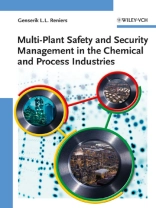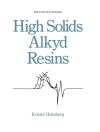This practical text serves as a guide to elaborating and determining the principles, assumptions, strengths, limitations and areas of application for multiple-plant chemical safety and security management. It offers guidelines, procedures, frameworks and technology for actually setting up a safety and security culture in a cluster of chemical companies, thus allowing forward planning. The presentation is conceptually rather than mathematically oriented so as to maximize its utilization within the chemical industry.
Innehållsförteckning
Preface
INTRODUCTION
CHEMICAL RISKS IN A MULTI-PLANT CONTEXT
Introduction
Safety Risks Versus Security Risks
The Safety-Risk Spectrum
The Security-Risk Spectrum
Multi-Plant Chemical Risks
Multi-Plant Chemical-Risk Management
Hypothetical Benefits Associated with Multi-Plant Chemical Risks
Safety-Risk Assessment and Safety-Risk Management
Summary and Conclusions
A MULTI-PLANT SAFETY AND SECURITY CULTURE: THE REQUIREMENTS
Introduction
Encouraging Companies to Install a Multi-Plant-Safety and -Security Culture
The Present state-of-The-Art Deal with Safety and Security Risks
Coping with the Future: Developing a Multi-Plant-Safety and -Security Culture
Summary and Conclusions
A MULTI-PLANT SAFETY AND SECURITY CULTURE – THE PROCEDURES: ESTABLISHING A MULTI-PLANT SAFETY AND SECURITY MANAGEMENT SYSTEM
Introduction
Managing Safety, Quality, Environment, and Security
Plant-, Joint- and Multi-Plant-Safety and -Security-Management Stakeholders
Practical Recommendations for Achieving Plant or Multi-Plant-Safety Loop of Continuous Improvement
Practical Recommendations for Achieving Plant or Multi-Plant-Security Loop of Continuous Improvement
System Implementation
Summary and Conclusions
A MULTI-PLANT SAFETY AND SECURITY CULTURE – THE PEOPLE: FACILITATING MULTI-PLANT SAFETY AND SECURITY COLLABORATION
Introduction
A Multi-Plant-Safety-Management Framework
A Multi-Plant-Security-Management Framework
Summary and Conclusions
A MULTI-PLANT SAFETY AND SECURITY CULTURE – THE TECHNOLOGY: DEVELOPING THE TOOLS TO ADVANCE MULTI-PLANT SAFETY AND SECURITY
Introduction
A Multi-Plant Domino-Risk Methodology and -Decision Support Tool
Summary and Conclusions
ASSESSING, EVALUATING AND CONTINUOUSLY OPTIMIZING OPERATIONAL STAFFING LEVELS WITHIN A MULTI-PLANT AREA
Introduction
Staffing-Level (SL)-Assessment Management Model
Instrument for Existing Staffing-Level Assessment (IESLA)
The MCSL Method
Roadmap of Staffing-Level Assessment
The Way Towards Continuous Staffing-Level Improvement in Industrial Areas
Summary and Conclusions
MULTI-PLANT SITE-INTEGRATED SAFETY AND SECURITY GOVERNANCE
Introduction
From Individual Plant Safety and Security Know-How to Multi-Plant Safety and Security Knowledge
Towards a Design Code of Good Practice for Integrating Multi-Plant-Safety and -Security Building Blocks
Planning for Safety and Security Sustainability
Summary and Conclusions
GAME-THEORY: A MATHEMATICAL TECHNIQUE TO CONVINCE COMPANY TOP MANAGEMENT TO INVEST IN MULTI-PLANT SAFETY AND SECURITY
Introduction
Qualitative Discussion on Multi-Plant-Safety and -Security Investments
Two-Plant External Domino-Effects Investment Model
Two-Plant Martyrdom Games
Multi-Plant Games
Summary and Conclusions
CONCLUSIONS AND RECOMMENDATIONS
Introduction
Summary
Main Conclusions and Recommendations
APPENDIX
Instrument for Evaluating Security Staffing Levels
The IESLA Instrument
Instrument for Evaluating Safety Critical Staffing Levels
Om författaren
Genserik Reniers received his Ph D in Applied Economic Sciences from the University of Antwerp, after completing a Master`s degree in Chemical Engineering at the Vrije Universiteit Brussels. He lectures in general chemistry, organic chemistry, chemical process technology, industrial processes and thermodynamics at the University of Antwerp, Belgium. He is also visiting professor Risk Management at the Institute of Transport and Maritime Management in Antwerp. At the Hogeschool-Universiteit Brussel in Brussels, Professor Reniers lectures in prevention management, advanced occupational health and safety management and chemical processes/unit operations. His main research interests concern the collaboration and interaction between safety and security topics and socio-economic optimization within the chemical industry. He coordinates the Antwerp Research Group on Safety and Security (ARGo SS), unifying multi-disciplinary safety and security research at the University of Antwerp. He has extensive experience in leading research projects funded both by the Belgian government and the chemical industry. He is a Fellow of the International Congress of Disaster Management, Member of the Society for Risk Analysis and the Royal Flemish Society for Engineers and serves as an Associate Editor for the Journal of Loss Prevention in the Process Industries.












